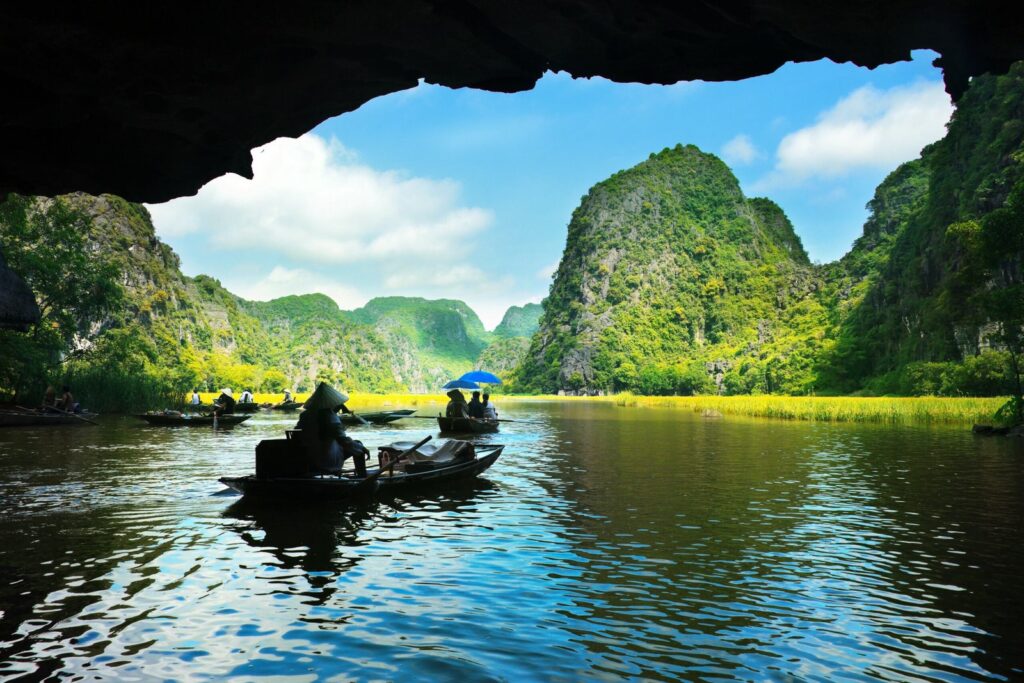About Vietnam
Welcome in Vietnam
Vietnam is a diverse country in Southeast Asia, known for its stunning landscapes, rich cultural heritage, and historical significance. With around 100 million inhabitants and a long, eventful history, Vietnam is one of the most populous and dynamic nations in the region.
The capital, Hanoi, in the north, and Ho Chi Minh City, the country’s largest metropolis in the south, form the political and economic hubs of Vietnam. Between them lie varied landscapes: mountains, dense forests, fertile river valleys, and over 3,000 kilometers of coastline lined with tropical beaches.
Modern development meets deeply rooted traditions, while everyday life is shaped by a vibrant culture and the legacy of imperial dynasties, colonial times, and more recent history.
Geography
Historical and cultural cities
Vietnam is rich in cultural heritage.
The ancient imperial city of Huế, the centuries-old temple complex of Mỹ Sơn, and the charming old town of Hội An all reflect a long and eventful history, deeply rooted in tradition.
Even modern cities like Hanoi and Ho Chi Minh City showcase the fascinating contrast between past and present.
Landscapes and nature
Vietnam impresses with an extraordinary variety of landscapes.
In the north, majestic mountains and terraced
rice fields shape the scenery, while central Vietnam features lush hills and long stretches of coastline. The south is dominated by the tropical Mekong Delta – a vast network of rivers, canals, and floating markets.
Climate and Weather
Vietnam spans three distinct climate zones—North, Central, and South Vietnam.
The north experiences four seasons, including occasionally cool winters. The south has a tropical climate with warm temperatures throughout the year. Central Vietnam is characterized by hot summers and a pronounced rainy season.
Culture & History
Social Etiquette and Values
Great respect is shown to elderly people, and family is at the heart of social life in Vietnam.
Politeness, modesty, and a calm tone are important in conversations – direct criticism or loud behavior is considered impolite.
Shoes are removed before entering a home, and gifts are presented with both hands as a sign of respect.
Public displays of emotion or criticism are generally
avoided—harmony is regarded as a key social value.
Vietnamese Cuisine
Vietnamese cuisine is known for its light, aromatic dishes made with fresh ingredients.
Popular traditional dishes:
Phở
Gỏi cuốn
Bún chả
“Table manners”
Meals are typically eaten with chopsticks.
Before eating, it is customary to say “mời” – an invitation to eat and a sign of respect toward others at the table.
Dishes are often shared in the center of the table, with each person taking small portions onto their plate.
Never stick chopsticks upright into a bowl of rice, as this resembles a funeral offering and is considered disrespectful.
Top - Attractions in Laos
- Luang Prabang – A UNESCO World Heritage Site featuring
colonial architecture, temples (e.g. Wat Xieng Thong), and the Kuang Si Waterfalls. - Vientiane – The capital city, home to the golden stupa Pha
That Luang and the Patuxai triumphal arch. - Vang Vieng – Known for its spectacular karst landscapes,
caves, lagoons, and outdoor activities such as kayaking and
hiking.
History
Vietnam’s history is marked by centuries of resistance against foreign rule, a strong sense of cultural identity, and a long path toward independence and unity.
In the 19th century, Vietnam was colonized by France and became part of French Indochina. After World War II, Hồ Chí Minh declared independence in 1945, leading to the First Indochina War against France.
In 1954, the country was divided into North and South Vietnam. This was followed by the Vietnam War (1955–1975), which ended with the victory of the communist North and the reunification of the country. Since the 1980s, Vietnam has opened up and evolved into a key player in Southeast Asia.
Infrastructure
Vietnam has a well developed tourism infrastructure. The country is easily accessible thanks to a dense network of domestic flights, train connections, and comfortable long- distance buses.
In the cities, travelers will find modern hotels, restaurants, and a growing range of services. Especially in popular tourist regions, transportation and accommodation often
meet high standards.
However, in more rural areas, conditions can be simpler – but it’s exactly there that you’ll find the authentic charm of
Vietnam.
Top - Attractions in Cambodia
- Angkor Wat (Siem Reap) – The world-famous temple
complex and UNESCO World Heritage Site, a national symbol
and a highlight of Southeast Asia. - Phnom Penh – The capital city, featuring the impressive Royal
Palace, the Silver Pagoda, and the moving Tuol Sleng
Genocide Museum. - Koh Rong – A tropical island with white sandy beaches,
crystal-clear water, and a laid-back island vibe – ideal for
relaxation and snorkeling.
Top sights in Vietnam
Ha Long Bay: Between emerald-green waters, thousands of limestone cliffs rise majestically into the sky. The unique landscape is best explored by boat or kayak.
Hoi An: The old town enchants with colorful lanterns, historic alleys, and lively markets. Here, Vietnamese culture meets colonial architecture.
Phong Nha-Ke Bang NationalPark: Amid dense jungle forests lie gigantic caves, including the largest in the world. A paradise for adventurers and nature lovers.
